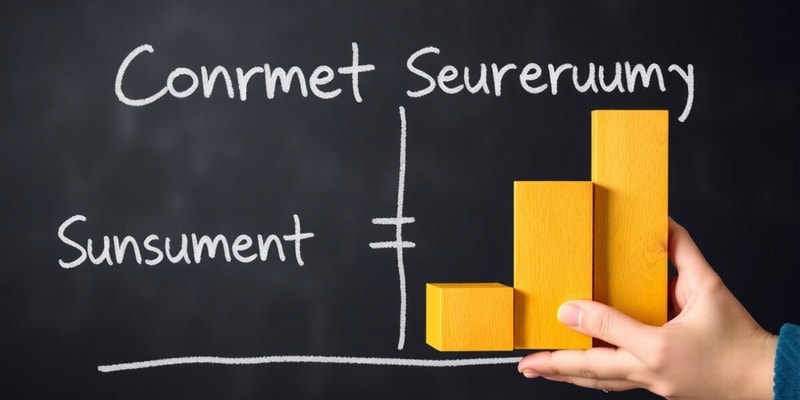Podcast
Questions and Answers
What happens to consumer surplus when prices decrease?
Producer surplus is the extra satisfaction producers gain when they sell at a price higher than what they were willing to accept.
True
What is defined as the sum of consumer surplus and producer surplus?
Social surplus
A market is in __________ when it is impossible to make someone better off without making someone else worse off.
Signup and view all the answers
Match the following terms with their definitions:
Signup and view all the answers
What happens to the supply of a good when its price decreases?
Signup and view all the answers
An increase in the price of a commodity leads to a decrease in the quantity supplied.
Signup and view all the answers
What is the shape of the supply curve?
Signup and view all the answers
As the price of a good decreases, the consumer's real income or purchasing power ______.
Signup and view all the answers
Match the following terms related to supply with their descriptions:
Signup and view all the answers
Study Notes
Market Efficiency
- Consumer surplus is the difference between what a consumer is willing to pay for a good and what they actually pay.
- Producer surplus is the difference between the price a producer receives for a good and the cost of producing it.
- Market equilibrium is a state where the quantity supplied of a good equals the quantity demanded. At this point, there is no tendency for the price to change.
- Pareto optimality is a state where it is impossible to make one person better off without making someone else worse off.
The Substitution Effect
- When the price of a good decreases, consumers will buy more of that good, substituting it for other goods.
- This change in purchasing behaviour increases the consumer's real income (or purchasing power).
The Law of Supply
- Supply is the quantity of goods a producer is willing and able to sell at a given price in a specific time period.
- According to the law of supply, as the price of a commodity increases, producers expand their supply by offering more onto the market.
- Conversely, as the price decreases, the supply decreases.
Supply Curve
- The supply curve shows the relationship between price and quantity supplied.
- It slopes upward from left to right.
- Higher prices lead to higher profits, motivating producers to supply more.
- An increase in price results in an expansion of supply.
- A decrease in price results in a contraction of supply.
Factors Affecting Supply
- Changes to production costs can significantly affect supply. Increased production costs decrease supply, while decreased production costs increase supply.
- Advancements in technology typically increase supply.
- Changes in prices of other goods influence supply. For example, an increase in the price of beef may increase the supply of chicken.
- Expectations of future events can affect supply. For example, an expectation of a major disruption could decrease supply.
- Weather can have a significant impact on supply, particularly for agricultural products. Bad weather conditions usually decrease supply.
- Taxes impact supply. Increased taxes (or increased costs) decrease supply.
Incentive Function
- Higher market prices incentivize producers to raise output because they stand to make a higher profit.
Price Ceilings
- Price ceilings prevent a price from rising above a certain level.
- When set below the equilibrium price, they can lead to shortages (quantity demanded exceeding quantity supplied).
- Price ceilings can also lead to lower quality products, black markets, and non-price rationing.
Market Disequilibrium
- Market disequilibrium occurs when the price is different from the equilibrium price.
- Free competitive markets naturally work to eliminate disequilibrium by adjusting prices to reach equilibrium.
Role of the Price Mechanism
- The price mechanism is determined by the forces of supply and demand in competitive markets.
- Adam Smith, the father of modern economics, called this the "invisible hand of the market."
- The price serves as a signal to both consumers and producers, indicating the relative scarcity of a good.
Functions of the Price Mechanism
- Rationing: Prices ration scarce resources when demand outstrips supply. Higher prices deter some consumers from purchasing the product.
- Signaling: Rising prices due to stronger demand signal to suppliers to expand output.
Nudge
- Nudge is a technique designed to influence consumer choices in a predictable way without imposing sanctions or limiting choice.
- Choice Architecture: Nudge theory seeks to modify choice architecture, the design of environments and the way options are presented, to nudge people towards certain decisions.
- Types of nudges:
- Default choice: The option chosen when the consumer does nothing.
- Restricted choice: When the government limits choices.
- Mandated choice: A free choice, but it is mandatory to make.
Critique of Maximizing Behavior
- Standard economic decision-making models are based on the assumption of rational self-interest:
- Consumers want to maximize their satisfaction.
- Producers want to maximize their profit.
- Workers want the highest possible wages.
- Investors want the highest possible return on investment (ROI).
Allocative Efficiency
- Allocative efficiency occurs when resources are allocated to the best interests of society, maximizing social welfare and utility.
- It considers the effects of consuming one extra unit of a good or service.
- Marginal benefits: The change in total private benefit from one extra unit.
- Marginal cost: The change in total private cost from one extra unit.
Productive Efficiency
- Productive Efficiency: When resources are used to give the maximum possible output at the lowest possible cost.
- Productive efficiency aims to maximize consumer welfare, but can be wasteful if goods and services consumers want are not produced.
Normal Goods vs. Inferior Goods
- Normal Goods: Demand increases when consumer incomes increase.
- Inferior goods: Demand drops when consumer incomes increase.
Invisible Hand
- The 'invisible hand' is a metaphor for the forces that drive the free market economy.
- Adam Smith's economic theory states that free markets, guided by self-interest, are the most efficient way to allocate resources.
Utility
- Total utility is the total satisfaction a consumer receives from consuming all units of a good.
- Marginal utility is the additional satisfaction a consumer gets from consuming one more unit of a good.
Law of Diminishing Marginal Utility
- As consumption of a good increases, marginal utility decreases with each additional unit consumed.
- Consumers are only willing to buy more of a good if its price falls.
Notes on Allocative Efficiency and Nudge Theory
- Allocative efficiency: Is not achieved when a price floor is established.
- Price floor: Leads to excess supply and decreased consumer surplus.
- Nudge Theory: A flexible way to understand human behaviour and decision-making. Nudge theory can be used to manage change and identify unhelpful influences on people.
Studying That Suits You
Use AI to generate personalized quizzes and flashcards to suit your learning preferences.
Description
This quiz covers key concepts in market efficiency, including consumer and producer surplus, market equilibrium, and the substitution effect. It also explores the law of supply and its implications for economic behavior. Test your understanding of how these principles interact in a market economy.




